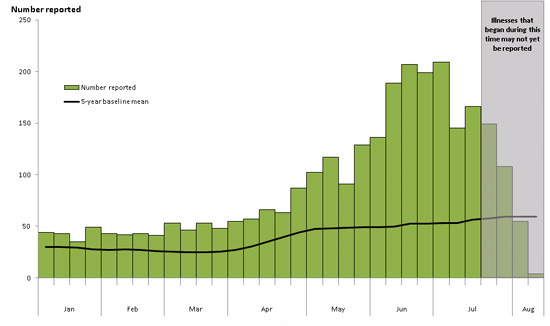The Salmonella-in-eggs situation gets worse
Judging from the number of interview requests today, everyone has figured out that the egg recall is not only awful for the people who got sick but also has something to do with our hopelessly inadequate food safety system and dysfunctional Congress.
The CDC has updated its statistics on the number of illnesses. Here’s what this epidemic looks like:
About 2,000 cases have been reported but the CDC does not yet know whether these are all related to this particular outbreak.
Here’s what’s special about this particular recall:
- Salmonella in eggs never used to be a problem until we had industrial egg production that puts hundreds of thousands of hens in close (very close) proximity.
- The company producing these particular eggs has a long history of rule violations.
- The company was not required to follow standard food safety plans. Whatever it had to do was voluntary.
- The FDA started writing rules for safe egg production more than 10 years ago. These were quashed. It finally got them done last July.
- The new safety rules for eggs went into effect this July 9, too late to prevent this outbreak.
- The FDA’s hands are tied by inadequate legislation and resources.
- The House passed legislation last August—one year ago—to give the FDA more authority and more resources. The Senate has been sitting on S.510 ever since.
The moral? Voluntary doesn’t work. We need mandatory food safety rules.
And sooner rather than later, no?


